Description: War Thunder is a next generation military MMO game dedicated to...


PDR technology (Paintless dent repair / paintless dent removal) - paintless dent repair / paintless dent removal, is a method of straightening minor dents from the car body. In German, this technology is called DOL - (Dellen Entfernung ohne Lackierung). Many types of damage can be repaired with PDR, as long as the paint is intact. PDR can be applied to both steel and aluminum body panels. The most commonly repaired PDR damage is hail dents, door dents, small creases in metal, extensive dents, and damaged stiffeners on body panels. American professionals of paintless damage repair sometimes call this technology PCR (Paintless Collision Repair - paintless repair of emergency damage), since sometimes we are not talking about simple dents and you have to fix quite complex damage without painting, which, at first glance, cannot be repaired without repainting details.
This method can also be used when straightening body panels before painting, minimizing the use of putty. Sometimes a layer of soil may be sufficient for final leveling.
Advantages of paintless dent repair technology:
To apply the PDR technology, the metal must not be stretched and the paintwork must not be damaged. However, there are techniques that allow solving the problem of even some stretching of the metal.
Most cars made in the 1990s and newer have flexible paint that will not crack under many metal deformations.
It is desirable that the time from the occurrence of a dent to its correction be minimal. Old dents are more difficult to squeeze out. This is due to the characteristic of the mechanical memory of the metal.
The stamped metal has a mechanical memory (especially the bulges), and the stresses created in and around the dent prevent it from returning to its original state. You can read about the alignment of the body, it describes the theory of elastic and plastic deformation of the metal. The task of a specialist is to remove stresses and help the metal straighten out. Visual control helps to determine the place of pressing or tapping.
PDR uses a series of gentle pressure on the reverse side of the damage to return to its original shape. Not all damage can be removed completely, but an experienced specialist can make even fairly complex damage invisible.
When repairing using PDR technology:
It is necessary to try to squeeze out a dent in several places. If it does not straighten well in one place, then you need to change the pressure zone. The main thing is that there are no traces of squeezing. The reflection of the stripes from the reflective panel helps to control the process.
When removing a dent with a PDR tool, the metal around its edges is slowly massaged and the metal slowly returns to its original state. When exposed from the edges, the dent becomes smaller and gradually disappears.
One of the most important aspects of PDR dent removal is lighting. There are many different types of lamps and reflective panels. The correct location and brightness and even the color of the lighting affect.
The task of visual control is to completely straighten the dent by observing the process so that it is not visible from any angle.
Lighting and reflective panels reveal the structure of the dent, allowing the craftsman to clearly see the recesses and elevations, as well as the movement of the metal as the tip of the tool is pressed against the panel. Visual control allows you to more accurately act on the dent.
It is advisable to use a large lamp for illumination, especially if the damage is extensive. For lighting, fluorescent or LED lamps are used, as well as reflective panels, for better control of the deformed metal during the repair process. Every smallest detail matters.
There are also reflective panels with built-in lighting.
An example of visualization of irregularities using a reflective panel
You can also work in sunlight, using an additional reflective panel.
In the process of editing a more complex damage, if necessary, the lighting can be adjusted several times to make it convenient to visually control the process of straightening.
Some craftsmen modify the lamps to suit their preferences. For example, dark lights or reflectors of different colors can improve visibility when repairing light-colored cars. Some technicians even wear sunglasses when fixing dents on white cars. So they can better see the configuration of the dent.
You need to install a reflective screen at the right angle (usually 90 degrees to the surface) so that the stripes from it are reflected in the repair area.
The master is on the side and looks at the reflection of the strips from the reflective screen in the damaged area.
The tool with the right tip is selected based on the dent and panel configuration. For initial practice, you need to use a sharp nozzle. This will make it easier to locate the tip of the tool on the back of the panel.
The instruments differ in size, bending configuration, tip thickness and shape. There are tools with interchangeable tips. A tool with a sharp tip is designed for point impact. It is convenient for them to raise small pits, especially at the final stage of repair. The tool with a round tip acts on larger areas and is the most commonly used. That is, the larger the tip, the larger the area it affects. The curvature of the tool affects the amount of pressure generated.

For more convenient and quick access, you can use different tools, different sizes and shapes. As a rule, an experienced master always has the most favorite tools that he often uses in his work. Understanding which tool for which panel and dent to choose comes with experience. The PDR tool requires a stop when working, you need to consider the configuration of the panel to provide a stop and choose the right access points.
Beginners should not focus on buying and learning a lot of tools. You need to learn how to master the basic set and, if necessary, buy new ones.
Sometimes, if necessary, you can make a tool of the desired configuration or modify an existing one.
 Punches with different tips for upsetting metal hills
Punches with different tips for upsetting metal hills You need to be able to place the tool inside the panel to get to the back side of the dent and position the tip of the tool in the right place without seeing the back side.
With a special punch, pins (protrusions) are removed and the edges of the dent are weakened.
Punches should have different tips to tap different heights. Fluoroplastic punches are able to slide over the surface without damaging the paintwork.
For the adhesive system, there are different "fungi" that are used in different places. With some it is better to pull out the center of the dent, with others the edges and stiffeners.
The stand is a simple design and can be made independently. It can be made from both metal and wood. The support points of the bench that will be in contact with the panel must be covered with rubber so that the repaired parts do not scratch. The hood or other panel on the stand must be fixed.

The stand for the hood or other panels is especially useful at the initial stage of training, to learn how to determine the location of the tip of the PDR tool being used. At any time, you can look under the repaired panel and orient yourself.
The advantage of working with the panel on the stand is that it is easier to set up the lighting and improve visual control.
It is desirable for a future PDR technology specialist not to have serious vision problems. Everything relies on visual control over the ongoing process. One of the most important aspects when learning PDR is the ability to "read the light", to be able to determine the boundaries of the dent. This is the key to controlling dent repair. It is important to learn how to interpret what is reflected in the paintwork. This is not easy to do at first. Ignoring the smallest details in the reflection will affect the result of the repair. Next, you need to develop muscle-visual coordination with good motor skills. Every millimeter of change in reflection must be taken into account when editing a dent.
You need to learn how to use a different tool that matches the circumstances of the repair.
The process of learning PDR technology requires patience, attention to detail and does not forgive haste. PDR technology will appeal to perfectionists who are ready to bring everything to the ideal without giving up halfway through.
An important point of training is communication with a PDR professional and observation of his work. It is important to get a good correct base, which is done under the guidance of a good specialist. If the initial base of knowledge and skills is not correct, then, with a lot of practice, the beginner will acquire the wrong skills.
When learning, you need to focus on understanding the process and take your time, speed will come with experience.
One of the skills required to repair a dent with PDR technology is the ability to get to the back of the damage.
The first thing to learn when learning about paintless dent removal is to constantly understand where the tip of the PDR tool is. You need to try to bring the tip of the tool closer to the dent and press the tip a little on the metal. So it will be clear where the tip is at the current moment. For a more accurate approach to the center of the dent, it is necessary, while continuing to press the tip on the panel from the back side, to move the tool to the place where the dent is located. Thus, the tip seems to slide to the right place and this is visually reflected in the reflection of the paintwork. This technique will help at the initial stage of training, when there is no experience in accurately positioning the tip of the tool. The next thing you need to know is to determine the areas where you need to press with the tip of the tool and determine the optimal method of pressure. It is also necessary to learn how to upset the heights of metal to the level of a common plane. It is necessary to calculate the procedure depending on the characteristics and location of the damage. When working on damage, it is necessary to divide the correction of a dent into stages.
Each individual dent requires an individual approach.
As mentioned above, the most convenient method of learning is to put an unnecessary hood on a repair stand and try to move the tip of the PDR tool and press on the metal, watching the process from both sides. You can make a smooth dent on the hood with a blunt object and train to straighten it.
When working with PDR technology, muscle groups are used that are rarely involved in everyday life. Requires hand and eye coordination. PDR requires a lot of trial and error to successfully understand the process. When training on unnecessary body panels, you need to try to push and upset the metal with different forces in order to understand the "behavior" of the metal.
A good starting point for a PDR novice is a knowledge of the body structure, as well as an understanding of the sheet metal characteristics of automobiles.
PDR takes a long time to master. The learning process continues during practice, as all injuries require an individual approach.
Once again, patience is an important part of learning and successfully applying PDR technology.
In learning and practice, you need to move slowly, do not make extra efforts when working with metal body panels. Beginners try to imitate the movements of tinsmiths and squash or tap the metal, which is absolutely wrong and leads to mediocre results. You need to do all the actions gradually, doing a lot of light repetitions. No need to try to fix the dent or part of it at one time.
At the initial stage of training, it is quite difficult to completely complete the straightening when the main part of the dent is straightened out. A slight indentation can only be seen when using a "reflective screen" by the unevenness of the strip reflected on the paintwork at the site of damage.
To access the back of the dent, it may be necessary to remove some parts of the car, for example, rear brake lights, interior parts.
Sometimes it is necessary to drill a hole from the side of the panel to access the right place on the back side. It is desirable to make the hole as small as possible and in places where it will not be visible or it will look normal, closed with a plug, like a technological hole. For example, having drilled a hole under the door seal, it will not be visible.
Sometimes, when there is no other option, it is necessary to drill a hole in the side of the panel to access the back of the dent. This option can also be used to quickly eliminate a dent so as not to do unnecessary disassembly. The hole is then closed with a special plug.
With the advent of a variety of new tools and fixtures, drilling holes, in most cases, can be avoided.
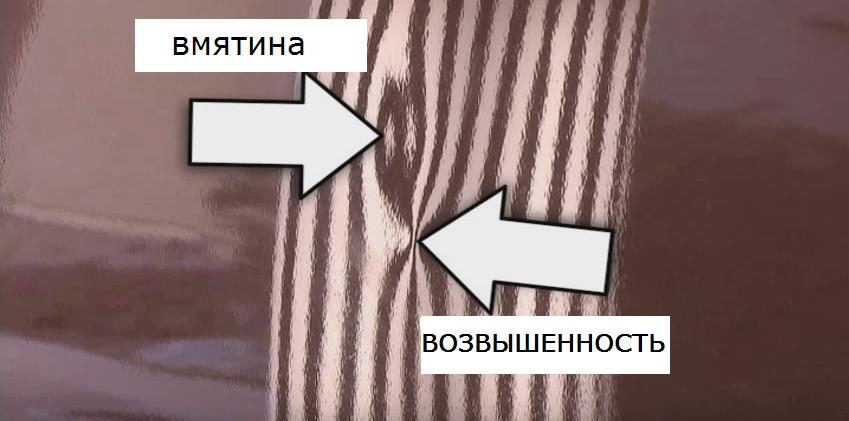

 1. The lines diverge on the panel reflection in the area of the dent 2. The lines converge on the panel reflection when the metal is convex and when pressed with the tip of the tool
1. The lines diverge on the panel reflection in the area of the dent 2. The lines converge on the panel reflection when the metal is convex and when pressed with the tip of the tool or by visiting our car service at the following addresses:
Moscow, SWAD, Northern Butovo, Kulikovskaya 12.
Moscow, CJSC, Solntsevo, Borovskoe highway, house 6 building 4
If you have insured your car under CASCO, in this case you can contact the insurance company and instead of sending it to the usual body repair using putty and straightening, you can take the insurance indemnity in cash and repair your car using dent repair technology without painting at Nikrasoff. As practice shows, such repairs are much cheaper and take several times less time. If the damage is not significant, then many do not apply for compensation under CASCO, but use the services of a master to remove dents without painting, so that the cost of insurance for the next year does not increase, but rather decreases.
One of the key factors is - a significant saving of your time. As a rule, repairs take from 30 minutes to several hours. In particularly difficult cases, if you need to quickly remove a dent from the surface of the car big size or a large number of dents (for example, from hail), straightening can take up to ten hours.
After the repair carried out by Nikrasoff, you will not have any restrictions on the operation of the car when driving a repaired car, unlike everyday body repairs, when it is necessary to limit the mechanical impact on painted parts (washing, wiping, exposure to weather conditions).
An important factor when selling your car will be that the body of the car is still covered with high-quality factory paintwork (paintwork), since very often potential buyers carry out a complete diagnosis of the car before buying, including for painted parts that indicate a car accident . Therefore, paintless dent repair is one of the latest modern advances in car body repair.
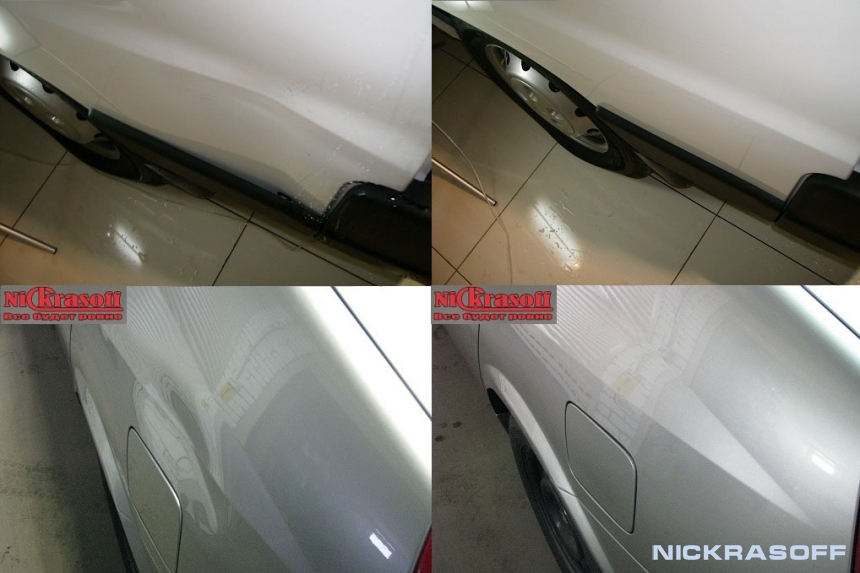
And perhaps the most pleasant and huge advantage is the several times cheaper cost of Nikrasoff car service for leveling dents without painting, compared to conventional body painting. Of course, you can turn to another - the classic version, which for a long time(before the advent of modern technology for repairing dents without painting) - this is a common, and often financially expensive body repair using straightening, puttying and painting, but it is not always done with high quality. After such a repair, when operating the car in Russian conditions possible peeling of varnish and putty.
In any case, you need to make an appointment in advance at a body repair station, since very often repairs in a good body service take a very long time.
After that, you need to leave the car for several days or weeks in order for the damaged part to be leveled, puttied, primed, painted and varnished (each of the items must go through drying).
In addition, even official dealers do not always match the color, and the painted part may differ from the factory coating. Thus, body repair of dents without painting is out of competition.
Car body parts that have damage to the stiffeners (as a rule) are not repaired, but changed, since the putty in such places can peel off.
Also body car parts, made of aluminum - do not putty, but change entirely, since the putty does not hold on aluminum parts.
Body paintless dent repair technology of the future which is already working. Many people think that this is impossible, but the master with the help of a special tool will restore the original appearance of your car.
Right before our eyes, dents disappear from the car body. In most cases, after such a repair, it is almost impossible to find a place where there was once a defect.
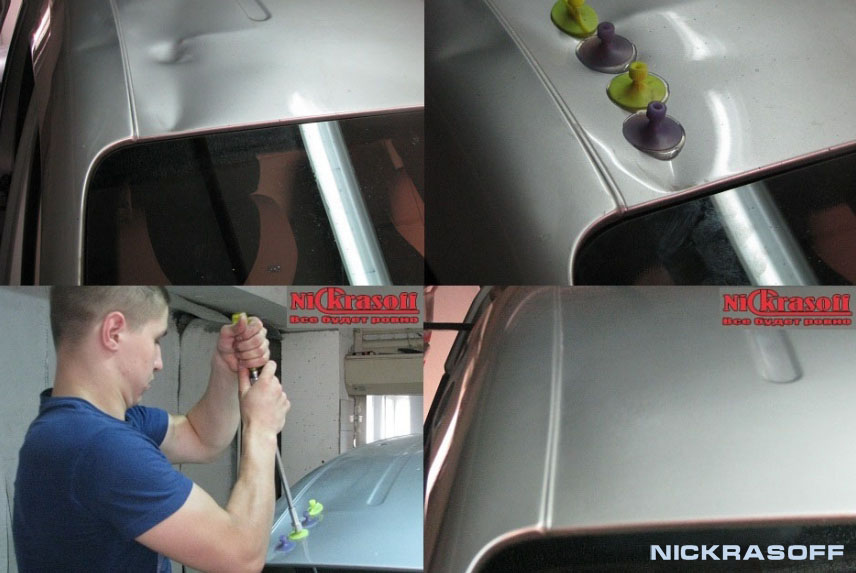
The master squeezes out the dent from the inside using a special tool, or from the outside using an adhesive system. Using such a tool, you can reach almost any place on the car body, and there is no need to disassemble the car or any of its parts (for example, doors, bumpers, fenders), or disassemble them partially (remove the trim, etc.).
The creator of a new and completely unique technology for repairing paintless dents was the German technician-engineer Oskar Flyg.
He applied it in 1952 at one of the Mercedes-Benz factories and subsequently, the technology of straightening dents without painting spread throughout the world.
The discovery of paintless dent repair technology was not accidental. Due to the fact that in the automotive industry in Germany
and the USA in the 50s, completely new paint and varnish coatings based on polymer compounds were introduced.
This led to the fact that when extensive and deep deformations occurred on a painted metal or plastic surface, the paint and varnish did not crack or peel off.
Also an important factor in the invention of the method of removing dents without painting was the use of more durable steels and aluminum alloys in car bodies, which led to a decrease in the thickness of body parts, and, accordingly, it became possible to easily squeeze out a dent with a metal hand tool.
However, quite recently, conventional body repair was the only way to repair all cars.
In the future, this technology began to be widely used in the United States, and then, in the late 90s, in our country.
Our specialists for the repair (removal) of dents without painting are ready to go to the place of repair in such areas as: Northern Butovo, Southern Butovo, Yasenevo, Chertanovo, Biryulyovo, Teply Stan, Konkovo, cities: Shcherbinka, Podolsk, Troitsk, Klimovsk, Solntsevo, Vidnoe .
You can also remove (repair) dents without painting in ZAO in such areas as: Kuntsevo, Ramenki, Troparevo - Nikulino, Novo - Peredelkino, Ochakovo, Krylatskoye, Mozhayskoye, Vernadsky Prospekt, Zarechye, Skolkovo, Bakovka, Moskovsky.
PDR technology is the repair of dents on a car body without painting, that is, with full preservation of the factory paintwork. Such a gentle removal of damage becomes possible due to the fact that the part is brought to its original form by mechanical action on it from the inside.
Result using PDR technology. Click on the photo to enlarge.
Paintless dent repair using Painless Dent Repair (PDR) technology has been used in the automotive service industry for quite a long time. Already in the 60s of the last century, in the states of employees of large automobile factories there were specialists whose main profile was the repair of dents without the need for subsequent painting. Later, the production of specialized tools for PDR alignment was established, and companies appeared that removed damage from the car body mainly by this method.
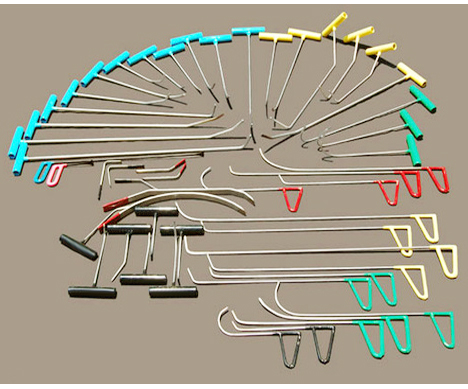
PDR Toolkit. Click on the photo to enlarge.
The founders of PDR technology are Oscar Delahoy and Henrich Nüssle, who were employees of the Mercedes factory and were responsible for the attractive appearance of the cars that acted as exhibits in the showroom. During the day, each visitor wanted to touch the car, and as a result, small dents remained on the body from careless handling. Of course, the above workers did not have a specialized tool, but thanks to many years of experience and skillful handling of improvised means, they could give the car such a look overnight as if it had just rolled off the assembly line.
Their skill could not fail to interest other Mercedes mechanics and employees of other car dealerships, so special PDR schools soon appeared. Over time, this approach gained more and more followers, the technology became more and more complex, acquired its own arsenal of tools and equipment. As a result, dent repair without further painting has become a reality even for significant damage.
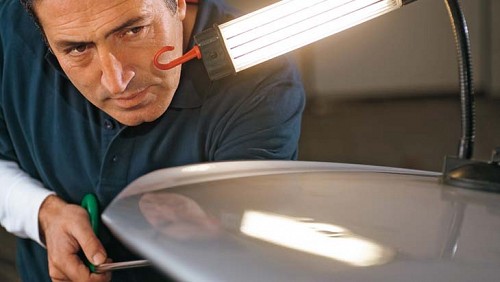
Good lighting is an important aspect when evaluating the future work front. Click on the photo to enlarge.
The tool that the PDR specialist picks up first is a lamp with a powerful diffuser that helps to “read” the dent, that is, to assess its size, depth, and the condition of the paint layer. Repair is not complete without hooks that extrude dents from the inside out, and without an adhesive system that allows you to correct the geometry of the part from its outside if there is no access to the inside.
PDR removal of dents on the car body without the need for further painting became especially in demand in the 90s of the last century, when application paintwork materials on a car has become more high-tech, and paints and varnishes - more elastic and less caustic.
The scheme for car repair using PDR technology can be different depending on the condition of the metal and body paintwork, as well as the size, depth and location of the dents. The impact on the damage can be carried out both from the inside and from the outside, as a result of which the dent is either pushed out or pulled up.
According to modern technology, PDR, unfortunately, cannot be called universal. There are some restrictions on its use related to the nature and location of the dents, as well as the features of the car body and the condition of its paintwork. The first type of restrictions include the following:
It is also inappropriate to resort to PDR alignment if the car body or its individual elements correspond to one of the following points:
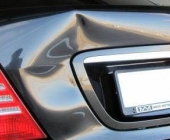
In our studio there is the possibility of removing dents without painting. it innovative approach for body repair that allows you to remove dents on the car body without any dismantling of the part or its repainting.

- preservation of factory paint;
repainting a part in color is still not easy in our city, and even if you have such skillful hands, the quality of materials will still be t is strikingly different from those that were used in the factory.
If we are talking about selling a car, the repainted place is determined by a thickness gauge in a second, but the PDR system allows you to fix a dent without affecting the main thing that catches your eye during the sale - the paintwork. The place of the former defect will not be determined by either high-precision equipment or a professional appraiser.
- less time repair;
PDR takes a completely different path and allows you to reduce the work to 1 hour. PWith the classical method of eliminating a defect,required from one day to several days. In thatThe process involves specialists from narrow areas (tinsmith, painter, polisher, etc.) and it is physically impossible to miss any of them. This fundamentally affects not only the cost, but also the time.
- low cost.
the cost of classical defect elimination consists of the participation of a number of specialists, as well as the cost of Painting works. PDR allows you to avoid the latter and minimize the participants involved in fixing the defect. And given fact significantly reduces the cost of the entire repair.

The purpose of PDR technology is to return the metal to its pre-accident state. Despite the simplicity, which may seem so at first glance, this type of repair is notable for its considerable complexity. The studio uses special tools to pick up the keys to many dents; lighting lamps that provide an opportunity to catch even the slightest defects, returning the metal to an exceptional original state, a wide selection of clips, reverse hammers and much more. Part of the work of the master is carried out from the reverse side of the part, allowing you to avoid even the thought of dismantling it, and in the process only special regular technological holes are used.
These approaches and competent technical training allow you to remove a wide range of dents, from a diameter of a few millimeters to a depth of several centimeters.
The only limitation of PDR technology is work with old Soviet cars (and a few old foreign cars), since the paintwork of these cars is of poor quality and exhibits its extremely fragile properties.
Otherwise, the paintless dent removal system is a great tool to save you money, save you a lot of time, and achieve results without interfering with the factory coating of the car. This system is an indispensable option, both for minor injuries and for significant ones. And we are pleased to realize that from now on in the studio you can not only give the car an exceptional look, but also support you in the troubles described in this section.
| Description of dents | Price |
|---|---|
|
Dents on car parts, except for the roof, with good access, no paintwork defects, no pronounced bottom, no need to disassemble the part, all cars except the premium segment. The size of the dent is up to 2 ruble coins. |
1000-2000 |
|
Dents on car parts, except for the roof, including difficult access, including disassembly of the part, all cars, except for the premium segment. The size of the dent is up to 7 cm. |
2000-5000 |
| Dents on the roofs of cars, as well as on all parts, having both a flat and a sharp bottom shape. Dents on aluminum parts, dents on the pillars, with paintwork defects, including the premium segment.
The size of the dents is not limited. |
From 5000 |
|
All complex types of dents, dents with difficult access and the subsequent need to dismantle the part, all types of voluminous dents, with the need to polish the car. |
From 8000 |
Dent repair is an essential part of any vehicle. Bad roads, non-compliance with traffic rules by many drivers, natural disasters can cause significant damage to the "iron horse". Compared to conventional straightening, the revolutionary PDR technology has undeniable advantages:
The use of PDR technology is not possible if:
Service stations today offer dent removal services in a variety of ways. But only PDR allows you to restore the geometry of the part without painting. Paintless dent removal is based on advanced German technology, hallmark which is the refusal to use consumables.
Paintless Dent Repair - technology for leveling defects without painting was first tested in the mid-50s at the factory " Mercedes Benz" in Germany. Today it is widely used all over the world, especially in the USA, where they have already introduced new equipment, having finalized some technological processes. Since the 90s, PDR has been actively developed in Russia.
The revolutionary technology developed due to the introduction in the automotive industry of Europe and America of paint coatings based on polymer compounds, the strong and flexible structure of which is maintained even with severe deformations. The last decade characterizes the use of thin and strong metals in the production of cars, which allowed new technology largely replace standard body work, which until recently was the only option for body restoration.
Straightening dents without painting can be compared to an art that requires not only the appropriate tools from leading manufacturers in Germany and the USA, but also high professionalism. Only specialists who own all the intricacies and secrets of technology will straighten out any deformation of the body resulting from mechanical damage, unsuccessful parking or inaccurate opening of doors. The price of repairing dents without painting in Moscow may vary depending on the size and number of damages, their location and availability. In any case, the restoration of local deformation using PDR technology is 50–70% cheaper than the cost of straightening and painting the part using traditional methods.
Fill out an application, and we will definitely return your car to its original appearance, and you will be in a good mood!
Sooner or later, even the most careful driver will have dents on his car. What to do in this case is understandable. You need to drive the car to the service station, leave it there for a few days and get an already straightened “iron horse”.
But you can go the other way - faster, easier and cheaper. What? Do it all yourself with PDR technology.
 Pulling out a dent with PDR
Pulling out a dent with PDR Initially, it should be noted that PDR technology is applicable only if the damage is shallow, and painting can be dispensed with. To determine this, check out the classification:
If mechanical damage on your machine can be attributed to the first group, then the PDR method will save the situation.
Dents on the car are corrected with the help of special hooks. By pressing on the damage, the metal is straightened. The PDR set looks something like this:


The number of levers can reach up to 40 pieces or more. But such kits are already for professional auto repair shops.
In addition to special levers, a fixture in the form of a table lamp is required. This is necessary in order to accurately determine the extent of the dent and correctly straighten the metal. In general, it is not difficult to do such work yourself.
Before you start repair work to remove dents without painting, you need to carefully inspect the damaged surface of the car. Do it better in bright light. Also, when diagnosing, carefully inspect the condition of the paintwork. If it is severely damaged, then it will not work to straighten the metal using PDR technology. In this case, you should use the classic straightening method, followed by painting.
Also note that the PDR method is not applicable if straightening has already been done in the area of \u200b\u200bmechanical damage and putty has been used. During the work, it will simply fall off.
There are such factors in which technology without painting is not applicable:
In all other cases, this method can be safely applied in practice.
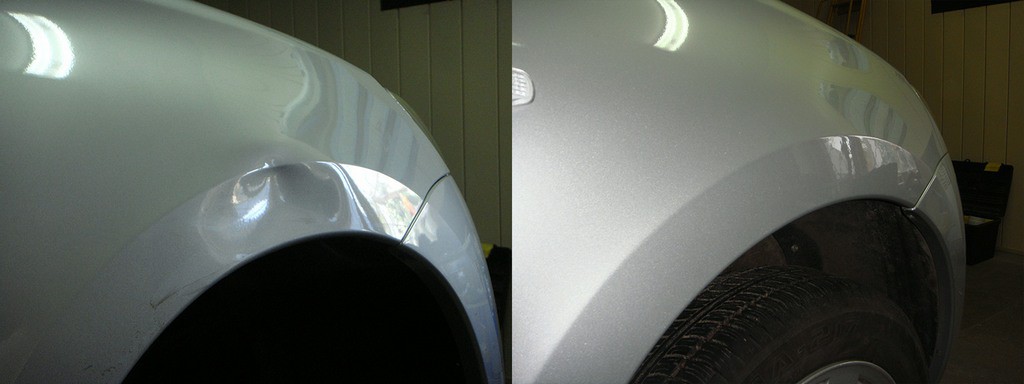
 Removing a dent using the PDR method
Removing a dent using the PDR method First you need to provide free access to the inside of the machine. It is necessary to remove everything superfluous: trim, mirrors, handles, etc. After the surface of the car is “free”, repairs can begin.
A special "lamp" is installed on the surface. As a rule, it is included in the kit:
Next, the lever of the optimal length is selected. With smooth gradual movements, using the selected lever, pressure is applied to the metal from the inside in the dent area. This must be done very carefully and gradually, so as not to "transfer" the metal. That is why a special lamp is installed. Thus, the surface of the vehicle can be clearly seen.
Schematically, the repair process can be displayed as follows:

 Repair scheme
Repair scheme After the dent is “squeezed out” upward, the surface should be treated - to make it perfectly flat. For this, a special hammer and a plastic cone are used. The damaged surface is tapped. Thus, the metal is completely leveled.